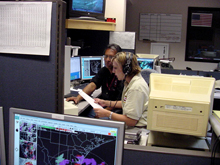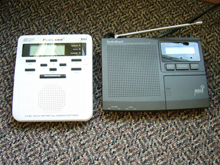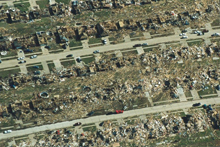NOAA Weather Radio
- Saved by NOAA Weather Radio!
- Weather Radio-All Hazards
- Data, Forecasts, and Warnings
- Evolves, Grows, and Matures
- Beyond Weather Forecasts
- Buying NOAA Weather Radios
- Summary
Saved by NOAA Weather Radio!

National Weather Service employees in the Brownsville, Texas, Weather Forecast Office broadcast a warning over NOAA Weather Radio during Hurricane Emily in July 2005. Click image for larger view.
Anyone ever caught in violent or extreme weather or other natural or civil emergencies knows the fright, the terror, and the panic they can inflict on the mind and body. Consider these real-life weather emergencies:
- During the overnight hours of February 14, 2000, tornadoes ripped through parts of southwest Georgia killing 18 people and injuring many more. Some of the survivors credited NOAA Weather Radio with waking them up in time to take cover.
- A supervisor at a plastics plant in Haysville, Kansas, saved more than 80 lives during the May 3, 1999 tornado outbreak by responding to official warnings on the plant’s NOAA Weather Radio. Shortly after instructing employees to move to the basement, a twister devastated the entire building. No one in the plant was hurt.
- In November 2002, a tornado swept along a 53-mile path in northwestern Ohio, claiming four lives and injuring 26. Alerted by a warning from NOAA Weather Radio, an assistant cinema manager and his staff evacuated more than 50 adults and children from a theater. Just minutes later, the powerful storm tore off the building's roof and tossed cars into the screen and front seats where parents and children had been watching a movie.
For many in cases like these, NOAA Weather Radio was the difference between life and death.
NOAA Weather Radio-All Hazards

Forecasters broadcast on NOAA Weather Radio at very high frequencies, requiring special radios to receive the transmitted signals. These radios are widely available for between $20 and $100 dollars from many manufacturers and retail outlets. Click image for larger view.
NOAA Weather Radio is a public service and foundation product of NOAA's National Weather Service that broadcasts weather forecasts, warnings, watches, and other non-weather related hazard and emergency information 24 hours a day. During a weather emergency, forecasters interrupt routine NOAA Weather Radio programming and send a special tone to activate weather radios in the forecast area affected. Weather radios equipped with a special alarm-tone feature sound an alert to give listeners immediate information about a life-threatening situation. This alarm-tone activation feature works when the radio is plugged in and turned on in mute or stand-by mode. Hearing impaired persons can connect specially designed radios to other attention-getting devices like strobe lights, bed shakers, computers, printers, and the like.
Weather Data, Forecasts, and Warnings

The tornado outbreak of May 3, 1999, brought near total devastation to this Oklahoma City neighborhood. NOAA Weather Radio makes every effort to warn residents of these impending disasters. Click image for larger view.
NOAA’s National Weather Service is the primary and official source of weather data, forecasts, and warnings during life-threatening weather emergencies for the United States. All television weathercasters and private meteorology companies prepare their forecasts using this information. NWS issues more than 734,000 weather forecasts (fire weather, public, aviation, and marine) and 850,000 river and flood forecasts annually. Most of these are routine and not life-threatening. However, of these forecasts, between 45,000 and 50,000 are potentially life-saving severe weather warnings. Severe weather warnings mean nothing if those in harm’s way do not see or hear them, so NOAA Weather Radio is a fundamental means for NOAA to disseminate its thousands of forecasts and warnings to the American public. Forecasts for hurricanes, tornadoes, floods, severe thunderstorms, hail storms, ice storms, and extreme winds and temperatures trigger emergency warnings on NOAA Weather Radio.
NOAA Weather Radio Evolves, Grows, and Matures
The origin of NOAA Weaher Radio traces back to the 1950s when the Weather Bureau—the forerunner of today's National Weather Service—began broadcasting aviation weather across two radio stations. In the 1960s, it added stations to serve the marine community. By the late 1970s, NOAA Weather Radio grew to more than 300 stations. NOAA Weather Radio now transmits warnings from more than 960 stations, covering all 50 states, adjacent coastal waters, Puerto Rico, the U.S. Virgin Islands, and the U.S. Pacific territories. Broadcasts cover a 40-mile radius, depending on the terrain and the location and quality of radio receivers and antennae, and reach about 98 percent of the U.S. population. The broadcasts emanate from the 122 NOAA National Weather Service forecast offices around the country.
Beyond Weather Forecasts and Warnings to “All Hazards”
In June 2004, NOAA and the Department of Homeland Security agreed to send critical alerts and warnings directly through the NOAA weather radio network for “all hazards.” This expanded NOAA Weather Radio to include warnings and post-hazard information for: natural non weather hazards such as earthquakes, volcanoes, avalanches and wild fires; public safety incidents such as AMBER (missing children) alerts, 911 telephone outages, and terrorism; and environmental hazards such as chemical releases or oils spills. As of 2006, approximately 97,000 U.S. public schools have radios capable of receiving NOAA Weather Radio-All Hazards broadcasts to alert students of approaching danger.
Buying NOAA Weather Radios
NOAA Weather Radio refers to the weather programming and “all hazards” alerts that are broadcast over the airwaves. NOAA Weather Radio does not refer to the radio equipment that receives the broadcast signals. NWS neither manufactures weather radios nor endorses any make or model that is available through manufacturers, retail stores, or the Internet. However, NOAA Weather Radio helps consumers know what consider when buying a radio that is capable of receiving NOAA Weather Radio signals. The cost of such a radio ranges from $20 to $100.
Summary
NOAA Weather Radio is a fundamental means for NOAA’s National Weather Service to disseminate continually its hundreds of thousands of annual forecasts, warnings, and watches to the American public. Safety experts believe that radios capable of receiving NOAA Weather Radio broadcasts should be standard safety equipment for all homes and public places. The benefits of NWR are far reaching and in many instances life saving and another example of NOAA’s 24/7/365 uninterrupted service to the nation.










